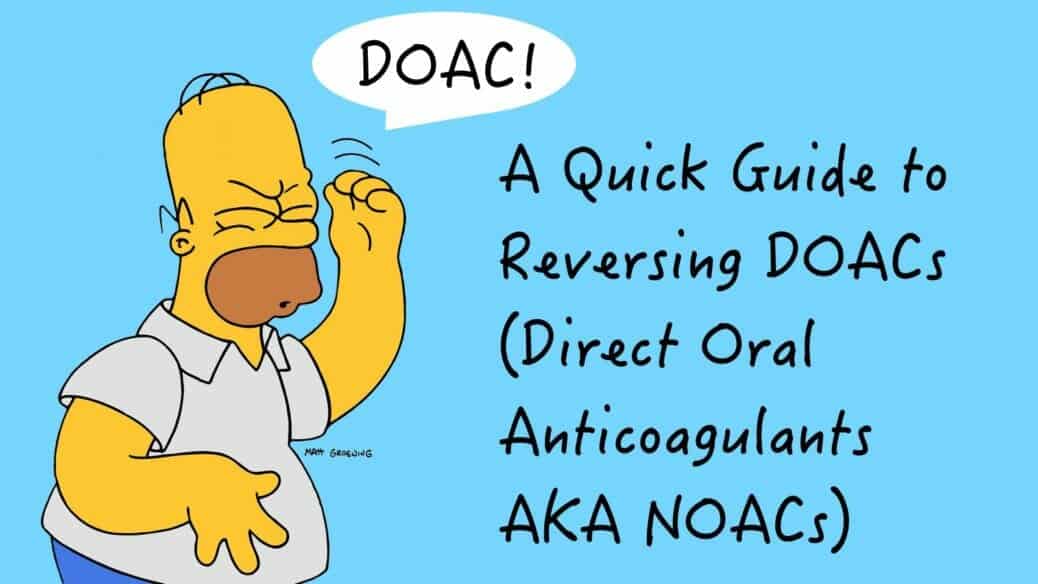A Quick Guide to Reversing DOACs
A Quick Guide to Reversing DOACs
Direct Oral Anticoagulants AKA Novel Oral Anti-Coagulants – NOAC’s
By Will Hare
Novel oral anticoagulant use has grown exponentially in the last few years. Dabigatran, a thrombin inhibitor, was originally licensed for use in the US in 2010 and this was followed shortly afterwards by the release of rivaroxaban, apixaban and edoxaban, all direct factor Xa inhibitors. The clinical need for these agents arose from the difficulties in titrating and monitoring vitamin K antagonists (warfarin) however great concern remains around the use of these novel agents given the relative lack of effective reversal strategies.
Idarucizumab is an antibody fragment recently developed and licensed in the US which targets dabigatran and has been shown to effectively reverse its anticoagulant effect. Andexanet alfa and ciparantag are currently undergoing investigation as agents for reversal of factor Xa inhibitors.
In this article we hope to summarise the key facts about these novel oral anticoagulants and present the latest evidence on reversing their anticoagulant effects.
Click below to learn more…
| PHARM | DABIGATRAN |
|---|---|
| Mechanism | Oral direct thrombin inhibitor |
| Half life | 12-17 hours |
| Dose | 75mg or 150mg tablets BD dependent on CrCl |
| Elimination | Mostly Renal |
| Protein Binding | ~ 35% |
| Effect on APTT | Prolonged – not quantifiable |
| Effect on PT | Prolonged – insensitive |
| Effect on TT | Prolonged – overly sensitive |
| Quantitative Measurement | Echarin Clotting Time, Echarin Chromogenic Assay, Dilute Thrombin Time |
| PHARM | RIVAROXABAN |
|---|---|
| Mechanism | Oral Factor Xa inhibitor |
| Half life | 5-9 hours |
| Dose | 10mg, 15mg, 20mg tablets dependent on CrCl and indication |
| Elimination | Mostly Hepatic |
| Protein Binding | > 90% |
| Effect on APTT | Not useful |
| Effect on PT | Prolonged – not quantifiable |
| Effect on TT | Not useful |
| Quantitative Measurement | Chromogenic anti factor Xa assay |
| PHARM | APIXABAN |
|---|---|
| Mechanism | Oral Factor Xa inhibitor |
| Half life | 6 hours singe dose, 12 hours with repeat dosing |
| Dose | 2.5mg to 5mg BD dependent on age, weight and serum Cr |
| Elimination | Mostly Hepatic |
| Protein Binding | > 85% |
| Effect on APTT | Not useful |
| Effect on PT | Prolonged – not quantifiable |
| Effect on TT | Not useful |
| Quantitative Measurement | Chromogenic anti factor Xa assay |
| Dabigatran (Pradaxa) | Rivaroxaban (Xarelto) | Apixaban (Eliquis) | |
|---|---|---|---|
| Mechanism | Oral direct thrombin inhibitor | Oral Factor Xa inhibitor | Oral Factor Xa inhibitor |
| Half life | 12-17 hours | 5-9 hours | 6 hours singe dose, 12 hours with repeat dosing |
| Dose | 75mg or 150mg tablets BD dependent on CrCl | 10mg, 15mg, 20mg tablets dependent on CrCl and indication | 2.5mg to 5mg BD dependent on age, weight and serum Cr |
| Elimination | Mostly Renal | Mostly Hepatic | Mostly Hepatic |
| Protein Binding | ~ 35% | > 90% | > 85% |
| Effect on APTT | Prolonged – not quantifiable | Not useful | Not useful |
| Effect on PT | Prolonged – insensitive | Prolonged – not quantifiable | Prolonged – not quantifiable |
| Effect on TT | Prolonged – overly sensitive | Not useful | Not useful |
| Quantitative Measurement | Echarin Clotting Time, Echarin Chromogenic Assay, Dilute Thrombin Time | Chromogenic anti factor Xa assay | Chromogenic anti factor Xa assay |
| OPTION | DABIGATRAN |
|---|---|
| Antidote | Idarucizumab – monoclonal antibody completely reverses dabigatran within minutes. Licensed by FDA, recently approved in Australia |
| Cryoprecipitate | no evidence |
| Prothrombinex | consider – limited evidence |
| Activated Products (factor eight inhibitor bypass activity – FEIBA, recombinant factor seven a – rFVIIa) | consider – limited evidence |
| Antifibrinolytics | no evidence |
| Activated Charcoal | within 2 hours of administration |
| Haemodialysis | consider – limited evidence |
| OPTION | RIVAROXABAN |
|---|---|
| Antidote | Andexanet alfa – not yet licensed.
Decoy factor Xa molecule able to bind factor Xa inhibitors and reverse their effects on clotting times. Undergoing phase 3b-4 trials in patients on DOACs who have acute major bleeding. |
| FFP | no evidence |
| Cryoprecipitate | no evidence |
| Prothrombinex | consider – limited evidence |
| Activated Products (factor eight inhibitor bypass activity – FEIBA, recombinant factor seven a – rFVIIa) | consider – limited evidence |
| Antifibrinolytics | no evidence |
| Activated Charcoal | within 2 hours of administration |
| Haemodialysis | no evidence |
| OPTION | APIXABAN |
|---|---|
| Antidote | Andexanet alfa – not yet licensed.
Decoy factor Xa molecule able to bind factor Xa inhibitors and reverse their effects on clotting times. Undergoing phase 3b-4 trials in patients on DOACs who have acute major bleeding. |
| FFP | no evidence |
| Cryoprecipitate | no evidence |
| Prothrombinex | consider – limited evidence |
| Activated Products (factor eight inhibitor bypass activity – FEIBA, recombinant factor seven a – rFVIIa) | consider – limited evidence |
| Antifibrinolytics | no evidence |
| Activated Charcoal | within 2 hours of administration |
| Haemodialysis | no evidence |
Administration Guidelines
Expected Indications:
- Life threatening bleed on Dabigatran
- Need for urgent surgery in patient on Dabigatran
Current dose: 5g bolus (2 x 2.5g vials – 15 ml each, given as slow push)
Expected onset of action: almost immediate *
Monitoring prior to administration:
- Dabigatran level – currently slow to return
- aPTT – semi quantitative measure but unspecific
- Thrombin Time (TT) – semi quantitative measure and specific
- dilute Thrombin Time (dTT) – quantitative and specific but slow to return
N.B. Watch out for rebound Dabigatran action at 24 hours as the drug redistributes
- Ongoing prospective cohort study of 90 patients so far
- Two groups: A – Patients with life threatening bleeding, B – Patients requiring urgent procedures
- Primary Endpoint – Reversal of anticoagulant effects of dabigatran based on echarin clotting time or dilute thrombin time.
- Secondary Endpoint – Clinical resolution of bleeding
- Results: Normalisation of dTT in 98% of Group A and 93% of Group B. Clinical cessation of bleeding occurred at 11.4 hours. Thrombotic events occurred in 5 patients.
- Randomised, double blind, placebo controlled trial in 145 healthy elderly patients
- Patients received either apixaban for 3.5 days or rivaroxaban for 4 days then were randomised to receive either andexanet or placebo on day 4.
- Two Parts: Part 1 – patients received a bolus only on day 4, Part 2 – patients received a bolus then infusion on day 4
- Primary Endpoint – Reduction in anti-factor Xa activity
- Secondary Endpoints – thrombin generation, concentration of unbound rivaroxaban/apixaban
- Results: ANNEXA-A Part 1 = reduction of anti-factor Xa in treatment group by 94% vs 21% in placebo group (P<0.001), ANNEXA-R Part 1 = reduction of anti-factor Xa activity in treatment group by 92% vs 18% in placebo group (P<0.001)
- No adverse events noted
- A trial in patients on a Factor Xa Inhibitor with acute major bleeding is ongoing.

























